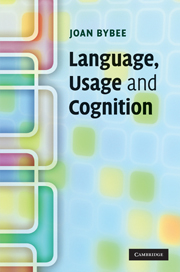Book contents
- Frontmatter
- Contents
- List of figures
- List of tables
- Acknowledgements
- 1 A usage-based perspective on language
- 2 Rich memory for language: exemplar representation
- 3 Chunking and degrees of autonomy
- 4 Analogy and similarity
- 5 Categorization and the distribution of constructions in corpora
- 6 Where do constructions come from? Synchrony and diachrony in a usage-based theory
- 7 Reanalysis or the gradual creation of new categories? The English Auxiliary
- 8 Gradient constituency and gradual reanalysis
- 9 Conventionalization and the local vs. the general: Modern English can
- 10 Exemplars and grammatical meaning: the specific and the general
- 11 Language as a complex adaptive system: the interaction of cognition, culture and use
- Notes
- Bibliography
- Index
3 - Chunking and degrees of autonomy
Published online by Cambridge University Press: 05 June 2012
- Frontmatter
- Contents
- List of figures
- List of tables
- Acknowledgements
- 1 A usage-based perspective on language
- 2 Rich memory for language: exemplar representation
- 3 Chunking and degrees of autonomy
- 4 Analogy and similarity
- 5 Categorization and the distribution of constructions in corpora
- 6 Where do constructions come from? Synchrony and diachrony in a usage-based theory
- 7 Reanalysis or the gradual creation of new categories? The English Auxiliary
- 8 Gradient constituency and gradual reanalysis
- 9 Conventionalization and the local vs. the general: Modern English can
- 10 Exemplars and grammatical meaning: the specific and the general
- 11 Language as a complex adaptive system: the interaction of cognition, culture and use
- Notes
- Bibliography
- Index
Summary
Introduction
In previous works I have focused attention on the role of repetition or frequency in the creation of linguistic structure through language change (see Bybee 2007). All the frequency effects I have identified work in conjunction with particular processing mechanisms. In this chapter and the next two, I examine the processing mechanisms whose repeated application gives shape to grammar, in an attempt to uncover the properties of these mechanisms. The goal, to the extent possible, is to identify the domain-general mechanisms that underlie language. These mechanisms, in conjunction with an exemplar model of linguistic representation and organization, can readily represent the ongoing modifications of the linguistic system that explain its patterning, as well as its synchronic variation and change over time.
By ‘processing’ I refer to the activities involved in both production of the message and the decoding of it. Thus the discussion includes in principle the set of cognitive and neuromotor mechanisms or activities that are put into use in online communication and in the mental storage of language. My hypothesis is that the particular way these processing mechanisms work determines fairly directly the facts about the nature of language. In particular, we will be examining the nature of chunking and the consequent phonetic reduction of repeated sequences, as well as the maintenance and loss of analysability and compositionality in complex expressions due to the effects of repetition.
- Type
- Chapter
- Information
- Language, Usage and Cognition , pp. 33 - 56Publisher: Cambridge University PressPrint publication year: 2010
- 1
- Cited by



